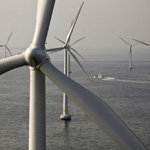Innovative foundations installed at potential site of large offshore wind farm
 One of the world’s largest offshore wind farms came a step closer to reality in recent weeks as suction-installed foundations for the project left their Irish shipyard to begin their journey to the site of the Dogger Bank wind farm, 125 kilometres off the UK’s east coast.
One of the world’s largest offshore wind farms came a step closer to reality in recent weeks as suction-installed foundations for the project left their Irish shipyard to begin their journey to the site of the Dogger Bank wind farm, 125 kilometres off the UK’s east coast.
The structures, known as bucket foundations, can reduce costs as there is no need for transition piece costs or additional grouting as would be the case for more traditional foundations.
They are literally gigantic steel buckets that will sink solidly into the sea floor using a suction method and jetting systems, as opposed to floating or more conventional monopole, jacket or tripod foundations which are generally tethered to the seabed. –
The structures will support two meteorological masts that will provide weather information that is essential for assessing available wind capacity. The met masts are set to be installed towards the end of February once the foundations are firmly in place.
The Dogger Bank project is being developed by Forewind, a consortium of RWE, SSE, Statkraft and Statoil, and with agreements already in place for the development of six wind farms, the group hopes to have up to 9.6GW of output by 2020. Ultimately the £3 billion (€3.47 billion) project could use thousands of wind turbines to generate as much as 10% of Britain’s power needs, according to the UK Carbon Trust.
The potential to produce huge amounts of electricity from offshore wind turbines is clearly there. The European Environment Agency (EEA) said in a 2009 report that offshore wind power’s economically competitive potential is around 3,400 TWh in 2030, about 80% of the EU’s projected electricity demand. Today offshore wind covers 0.5% of the EU’s electricity demand produced by a total of 5,000 MW of offshore power from 55 offshore wind farms across the continent.
Some have predicted that current high costs of developing offshore wind farms could fall by one-third by the end of the decade as experience develops and the supply chain becomes specialised. But for the moment, the extra expenses compared to onshore farms continue to pose a problem. Phil De Villiers, head of the Carbon Trust’s Offshore Wind Accelerator (OWA) programme, said he was therefore “excited” about what the use of this new technology could mean for offshore wind development. “The foundations [of offshore turbines] represent 30% of the total cost of a wind farm [and so] reducing the capital and installation costs could really make an impact on the viability of future projects,” said De Villiers.
The foundations were developed by the Danish firm Universal Foundation through the OWA programme, which aims to take the best designs for offshore wind turbine foundations and see them through from design to deployment.






